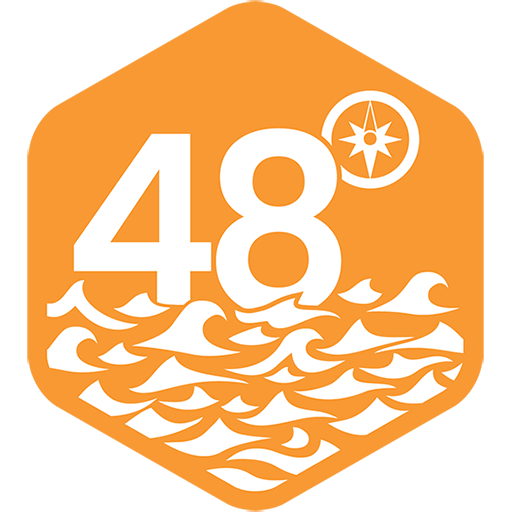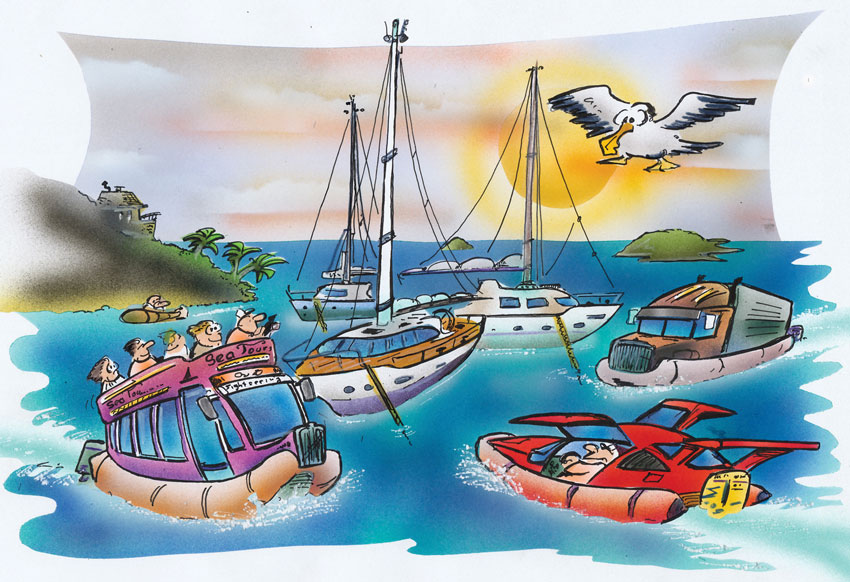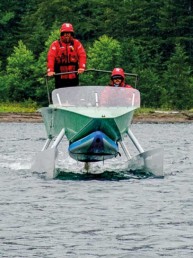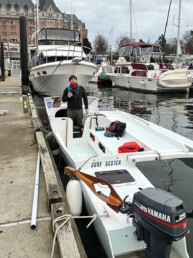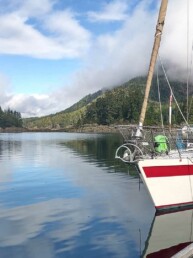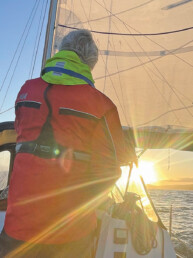From the February 2009 issue of 48° North by Gary W. Dickinson
“The dinghy is a sports car,
the top is always down and if it has a big motor it is a racer,
if you have a really big dinghy it becomes a bus.”
I was talking with Bruce and Dawn Turek of the sailing vessel Lady Hawk and they said, “The dinghy is a sports car, the top is always down and if it has a big motor it is a racer, if you have a really big dinghy it becomes a bus.”
That got me to thinking about the different role dinghies have here in the Keys and the Bahamas than they had for me back in the Northwest. Most of my cruising in the last few years has been in the Northwest, and having a shallow draft boat, a MacGregor 26x, the distances I had to travel by dinghy were not very far. Up until my current voyage, rowing the dinghy was not a big deal. I thought that it might be nice to have a little assistance, so I stole (borrowed) my brother’s electric outboard for this trip.
I have a wind generator and a small solar panel on my boat, so I was sure that I would have more power than I needed to charge the extra battery for the electric outboard. I even added a plug adapter so I could charge the battery in the cockpit. When I first used the electric outboard the battery was new and fully charged. It moved me around at nearly five knots which was much better than rowing.
Being in protected anchorages, I watched the battery level drop each day and knew I had a problem. Because I could not generate enough power for my boat, I could not generate the power needed to run the electric outboard. After a month of rowing and developing arms like Popeye, it was time to buy a real outboard for the dinghy.
I discovered my dinghy took on a different role when cruising in these waters. After two or three round trips a day rowing more than a mile to shore, I learned that I was not doing all of the things I would like to do if I did not have the challenge of such a long row. I had to get a gas powered outboard for my dinghy. The dinghy was my car. The size of the motor on your dinghy determines what type of car you have. I figure mine is an Escort. I bought a brand new Suzuki 2.5 HP motor. The reason for that choice was that it only weighs 28 pounds and I have a small boat. I can’t quite get on top of the water, but it is a hundred times better than rowing. The dinghy is your lifeline down here. It allows you to explore places you cannot get to with your vessel. In addition to hauling food, water, fuel and everything else back and forth from land, you use it for diving and socializing with other boaters. The situation here and in the Bahamas, my next destination, is much different than what I have done in the past. Instead of being a hundred yards from a destination, as was the case in the Northwest, I could be miles from where I wanted to go. With wind, current and waves, there are times when I simply could not row against it. I discovered how important it is to match your dinghy to the type of cruising you will be doing and the type of service it will be put into. Rather than go into the pros and cons of the various different types of dinghies I just want to let you know some things that I have learned.
There have been many changes in dinghies during the past few years. One of these changes is the inflatable floors on many of the current models. Most of these inflatable floors are made from a less durable material than the dinghies are themselves. As I looked at the numerous dinghies at the dinghy dock I noticed on many of the dinghies with the inflatable floors were deflated, patched or in some cases replaced with plywood which many earlier models had before switching to the new inflatable floors. It is easier to damage the floors of these dinghies than you might think. I have see owners toss sharp objects into the dinghies, fishing accidents and even thoughtless people tossing cigarette butts into them. One of the funniest stories I have heard relating to these new floors, happened to my friend Colin. A group of his friends on another boat watched an egret land on his dinghy. The bird proceeded to reach over the side of the dinghy and catch a fish. Naturally the egret dropped the fish into Colin’s dinghy. The egret then proceeded to use his sharp beak to stab the fish, missing numerous times putting many holes in the once inflatable floor of his dinghy. His buddies on the surrounding boat were of course, rolling with laughter at the sight they were witnessing. After numerous attempts to patch his once inflatable floor it still does not hold air. There is no safe haven for egrets when they get near Colin’s dinghy. Every close item becomes a projectile and the egrets had better know how to duck. I will share a solution that seems to work here. We protect the inflatable floors of our dinghies by using mats or what works for me is a rubber backed throw rug like a welcome mat only larger. The boaters who choose to do something to protect their floors are the only ones with inflatable floors that still work.
Another thing I discovered is the amount of stuff I need on the dinghy to cruise here is much greater than what I needed just go to shore or a dinghy dock back home. I carry two pumps, a bilge pump and a pump to add air to the chambers if needed. An anchor with twenty foot of chain and one hundred feet of line. A patch kit, running light for after dark, as well as all of the safety gear you should have onboard. Another must in this area is a twenty-five foot cable or chain with good locks to assure that I will have a way to get back to the mothership when you return from some activity ashore. I noticed that many of the dinghies had chains or cables and locks connecting their motors to the dinghies in addition to a way to lock the dinghy to the dock. Shortly after I arrived here I discovered the reason for that. In the first week here, two dinghies were stolen, and one was stolen twice. Luckily it was found tied to a dock on the other side of the harbor. Someone decided to take it to go to the other side of the harbor… twice. After the second time, the owners now have a cable with lock to attach their dinghy to the dock.
One of the last things I will mention is the apparent fuel issues we are having here. There are more than 300 boats in the harbor and the only way for people to get to shore is with their dinghies. Nearly every day I see people at the dinghy dock whose outboard won’t start. There are different speculations on what is causing this epidemic, but what I do know is that the carburetors on these outboards all need to be rebuilt at about $200 each, which helps the local repair shop but puts a big dent in cruising budgets. Many of the boaters use a funnel type fuel filter that separates the water and other impurities out of the fuel. These same boaters also use a fuel additive to help remove water, clean the engine parts and stabilize the fuel. The people who do this do not seem to have the issues that others have.
As you can see, my time here waiting on the weather has not been wasted. I am learning things that will make future cruising more safe and enjoyable and I am having a great time in the company of my extended family, fellow cruisers.
Joe Cline
Joe Cline has been the Managing Editor of 48° North since 2014. From his career to his volunteer leadership in the marine industry, from racing sailboats large and small to his discovery of Pacific Northwest cruising —Joe is as sail-smitten as they come. Joe and his wife, Kaylin, have welcomed a couple of beautiful kiddos in the last few years, and he is enjoying fatherhood while still finding time to make a little music and even occasionally go sailing.
